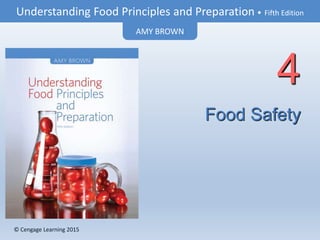More Related Content
Similar to Chapter 4 - Food Safety (20)
Chapter 4 - Food Safety
- 1. © Cengage Learning 2015
Understanding Food Principles and Preparation • Fifth Edition
AMY BROWN
© Cengage Learning 2015
Food Safety
4
- 2. © Cengage Learning 2015
• Food safety is a priority in the U.S.
– CDC investigates causes of foodborne
illnesses
– FDA and USDA share responsibility for
monitoring food supply
– Food defense: protecting against food
terrorism
Food Safety
- 3. © Cengage Learning 2015
• Symptoms include gastroenteritis,
nausea, abdominal cramps, diarrhea,
and vomiting
• Who is most vulnerable to foodborne
illnesses?
– Those who are very young, old, or with
compromised immune systems
• Most biological hazards can be
inactivated or killed by adequate cooking
What is a Foodborne Illness?
- 5. © Cengage Learning 2015
• Naturally occurring hazards
– Bacteria
– Molds
– Viruses
– Parasites
Biological Hazards
- 6. © Cengage Learning 2015
• Infection
– Salmonella, listeria monocytogenes,
yersinia enterocolitica, shigella
• Intoxication/poisoning
– Clostridium perfringens, staphylococcus
aureus, clostridium botulinum
• Toxin-mediated infection
– Escherichia coli, campylobacter jejuni, vibrio
Bacteria
- 9. © Cengage Learning 2015
• Produce mycotoxins
• Are visible, unlike bacteria
• Examples:
– Aflatoxin
– Patulin
– Fumonisins
Molds
- 10. © Cengage Learning 2015
• Foods with molds in general should not
be eaten
– Exceptions: certain cheeses (like bleu);
other foods (like soy sauce) that depend on
healthful molds
– Cheeses such Swiss and cheddar can be
cut one inch from the mold
– Soft cheeses like cottage or cream should
be discarded because the mold may
penetrate the cheese
Molds (cont’d.)
- 12. © Cengage Learning 2015
• Roundworms
– Trichinella spiralis
– Herring worms or cod worms
• Protozoa
– Giardia lamblia
– Toxoplasma gondii
Parasites
- 13. © Cengage Learning 2015
• Bovine spongiform encephalopathy
(BSE) found in cows
• When humans eat infected cows, they
develop a transmissible spongiform
encephalopathy (TSE)
• TSE attacks brain tissue
• USDA has tight regulations to prevent
outbreaks of mad cow disease
Prions—Mad Cow Disease
- 15. © Cengage Learning 2015
• Seafood toxins
– Ciguatera fish poisoning
– Histamine food poisoning
– Pufferfish poisoning
– Red tide
Chemical Hazards (cont’d.)
- 16. © Cengage Learning 2015
• Foreign items in the food supply
– Examples
• Glass
• Bone
• Metal
• Wood
• Stones
• False fingernails
• Insects
Physical Hazards
- 17. © Cengage Learning 2015
• Food allergy: immune response to a
protein
• Food intolerance: inability to digest a
food due to an enzyme deficiency
• Food sensitivity: general term
encompassing allergies, intolerances,
and other adverse reactions to foods
Food Allergy, Intolerance, and Sensitivity
- 18. © Cengage Learning 2015
• Best method of prevention is avoidance
• Food Allergen Labeling and Consumer
Protection Act (FALCPA) requires
manufactures provide warnings on labels
of foods containing foods that could
cause allergic reactions
• Prevention of cross-contamination
happens at all stages of food
manufacture and storage
Food Allergy, Intolerance,
and Sensitivity (cont’d.)
- 19. © Cengage Learning 2015
• Food service personnel
– Training
– Personal hygiene habits
• Purchasing from safe sources
• Inspection of food deliveries
Preventing Foodborne Illness
- 22. © Cengage Learning 2015
• Food storage
– Refrigerator
– Freezer
– Dry conditions
Preventing Foodborne Illness (cont’d.)
- 24. © Cengage Learning 2015
• Preparation
– Prepreparation
• Thawing; cross-contamination
– Cooking
• Minimum internal temperature
– Holding
• Time limit; protective barriers
Preventing Foodborne Illness (cont’d.)
- 25. © Cengage Learning 2015
• Preparation (cont’d.)
– Cooling
• Within four hours of cooking
– Reheating
• Within two hours before serving
– Serving
• Personal hygiene, cross-contamination
Preventing Foodborne Illness (cont’d.)
- 26. © Cengage Learning 2015
• Sanitizing dishes
– Heating
– Three compartment sink
– Chemicals
– Air- or heat-dried
• Sanitation schedule
• Sanitizing equipment
• Sanitizing facilities
Preventing Foodborne Illness (cont’d.)
- 28. © Cengage Learning 2015
• Pest control
– Blocking entrances
– Blocking access to food
– Pest-control program
Preventing Foodborne Illness (cont’d.)
- 29. © Cengage Learning 2015
• FDA Food Code
– Foundation for food safety programs
– Lists government safety recommendations
– Updated every few years
• Health Department inspections
– Too many violations can result in
suspension or revocation of license
Food Safety Monitoring
- 30. © Cengage Learning 2015
• Hazard Analysis and Critical Control
Points (HACCP)
– Assessing potential hazards
– Identifying critical control points (CCPs)
– Establishing quantifiable limits for each CCP
– Monitoring CCPs
– Taking corrective action
– Verifying through regularly evaluating
records
– Documenting through record keeping
Food Safety Monitoring (cont’d.)
- 31. © Cengage Learning 2015
• Types of foodborne illnesses
– Biological hazards
– Chemical hazards
– Physical hazards
– Food allergy, intolerance, and sensitivity
Chapter Summary
- 32. © Cengage Learning 2015
• Factors in preventing foodborne illnesses
– Personnel
– Purchasing
– Storage
– Preparation
– Sanitation
– Food safety monitoring
Chapter Summary (cont’d.)
Editor's Notes
- <insert new textbook cover>
- Table 4-1. Types of Foodborne Hazards
- Figure 4-2. Cartoon.
- Figure 4-5. How E. coli can cause serious health problems.
- Table 4-6. Viruses Causing Foodborne Illnesses
- Table 4-8. Potential Chemical Contaminants
- Figure 4-9. High-risk foods (high levels of protein/water) for disseminating foodborne illness.
- Figure 4-10. Food Road Risk. Risk factors on the road to foodborne illness.
- Figure 4-11. The temperature danger zone and its surrounding temperatures.
- Figure 4-17. Common pests that may transmit foodborne illness.
